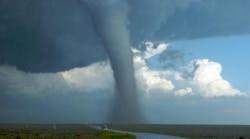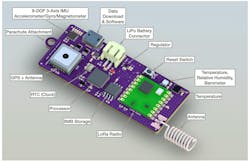For more tornado-related technology, check out "Tornadogenesis Identified with Infrasound—New Predictions Possible."
What you’ll learn:
- Gain insight into storm chasing.
- The hardware used to acquire data.
- The data collected from inside a tornado.
On May 28, 2019, the Dominator 3 vehicle was positioned just south of Lawrence, Kansas, where it remained waiting for the most opportune moment to launch a new type of rocket. One that would provide intel on an elusive target that was about to reveal itself within 200 yards of its position. Then it happened—a mile-wide EF4 long-tracked tornado came into view south/southwest of storm chasers Reed Timmer’s and Mark Simpson’s position.
The moment presented itself, and the pair took their shot, launching the probe-equipped rocket into the inflow notch of air just ahead of the tornado, where it was then vacuumed into the tornado’s vortex. It then beamed back live data every second as the pair proceeded to chase their target.
While that may sound like the beginning of a disaster movie, it was actually the culmination of extensive work in designing a trackable meteorological probe that could grab data from within a tornado. Launching a rocket into a tornado is no easy task either, requiring near-perfect positioning to hit the inflow notch. Timmer reported that the rocket’s parachute deployed at 800 feet before entering the vortex. Though slightly higher than the chasers wanted, it was nonetheless successful.
To that end, the pair have tested a myriad of airborne delivery mechanisms for deploying meteorological sensors into tornadoes over the past two decades, including air cannons, parachuted sensor packs dropped by RC aircraft, and ground-deployed inflatable plastic bubbles that were designed to be sucked up into the vortex. All had limited success.
Customized Rockets Send Sensor Probes into a Tornado
That experimentation led to one notion: Garnering data from inside a tornado would require raw speed, such as that provided by model rockets. Timmer and Simpson decided to employ a custom-modified Magnum Sport Loader dual-motor model rocket from Quest Aerospace (Fig. 1) with a pseudo-Lagrangian drifter deployment mechanism that would deploy a parachute with the sensor probe in tow.
The sensor probe (Fig. 2), designed by Simpson, was used to garner specific data while inside the tornado. It included a Bosch Sensortec BME280 barometric and humidity sensor, a Silicon Labs S17053 temperature sensor, and a Hillcrest Labs BNO085 IMU (three-axis magnetometer, accelerometer, gyroscope).
Positioning was handled by an OriginGPS ORG1411 Nano Hornet GPS unit with a built-in antenna, while communication was provided by a LoRa radio module with time-division multiple access (TDMA) and a coiled-wave monopole antenna. All of that was packed into a waterproof silicone case and powered by a 30-mAh lithium-polymer (LiPo) battery.
Timmer and Simpson built a pair of rockets, each with the same payload, and designed a mobile rocket launcher complete with pan-and-tilt capability that was mounted to the roof of the Dominator 3 vehicle. The motor and gears for the launcher were repurposed from the automated window-lift system of a junkyard vehicle, and a protective blast plate and a pair of launch rods were incorporated to accommodate multiple rockets.
Due to potential lightning strikes piggybacking from the rocket’s ionization trail, aiming control and firing were handled by a remote control operated by Simpson inside the armored vehicle.
After launching the rocket, the data the sensor probe sent back in real-time was picked up by a mobile ground station unit designed around a Raspberry Pi Zero with a custom LoRa daughterboard, an I2C-connected OLED display, and an omnidirectional wave monopole antenna for easy tracking. The receiving station made use of custom software from an onboard SD card and featured a real-time user interface via a web server accessed over a Wi-Fi network.
Rocket Speed and Height in the Tornado
The data they received was no less than remarkable. After the sensor payload was deployed at 800 feet near the tornado, it was immediately carried by the tornado, reaching speeds of 180 mph, and soared to 35,000 feet, where it experienced temperatures as low as 18 degrees. During its climb, the rocket's path encountered a “kink” at 11,000 feet, then shot upward at a speed of 122 mph, highlighting an extremely strong rising motion needed to spin up an intense tornado.
Once the sensor probe reached altitude and was no longer supported by the vortex updraft, it began to fall, reaching 123 mph on its way down, much like hail during strong storms.
During its time aloft, the sensor beamed back data every tenth of a second, way too much data to be transmitted to the relay station on the ground. So, the pair had to garner the information directly from the sensor probe, which landed 35 miles away.
What Did the Sensor-Probe Data Reveal?
According to a paper released by Timmer and Simpson, the data acquired by the probe showed “a flight time of 30 min sampled high 3D wind speeds of up to 85.1 m s−1, as well as an updraft velocity of 65.0 m s−1, and reached the upper troposphere at 11 914 m a.s.l. before descending. The probe completed 1.5 revolutions around the tornado in nearly axisymmetric flow during the 3 min within the tornado with a maximum updraft velocity of 65.0 m s−1. The substantial pressure deficit during the tornado phase of the probe trajectory and the lack thereof during the mesocyclone are expected due to tornadic winds being driven by tornado-scale gradients in pressure.”
Dr. Reed Timmer shows his rocket probe launch and explains the complete project’s design, goal, and results.
I spoke with Dr. Reed Timmer; he told me that they plan to continue the rocket design and builds. They have more launches planned in the near future. Of course, the method of deployment and the data received during their successful venture have been shared with other meteorologists, who can use the data to get a better understanding of tornadoes and increase public safety.
As of the writing of this article, Team Dominator launched a new storm chasing show directly on YouTube called “Twisters IRL.” Team Dominator has gone completely independent of any media backing as of recently, and for the better. We get easier access to their content—we can follow their scientific missions and even watch their hours-long live streams to see what real storm chasing is like.
Like the first episode says, Dr. Reed Timmer is the person they modeled one of the new characters in the 2024 film Twisters, which was just released on July 16, 2024. As much of a spectacle as the film will be, remember that storm chasing is rooted in science.
For more tornado-related technology, check out "Tornadogenesis Identified with Infrasound—New Predictions Possible."



